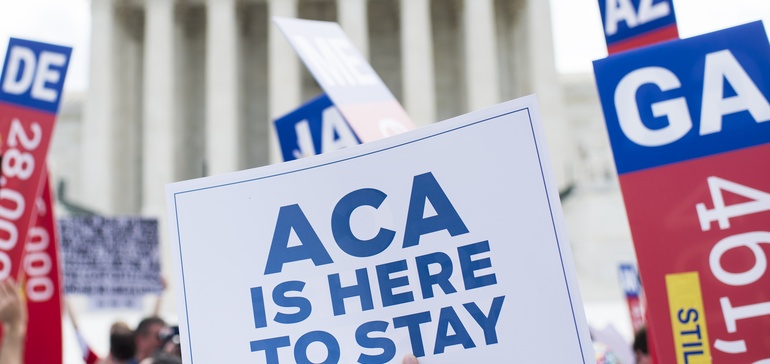
For all the partisan wrangling over the pivotal health law case, the Supreme Court Justices seem skeptical of whether the plaintiffs even have standing to bring the challenge against the Affordable Care Act in the first place.
The two-hour oral arguments held Tuesday largely centered on the question of standing, dominating the discussion more than any other topic. The word was mentioned at least 59 times, according to the court’s transcript of the hearing, outnumbering other key words such as severability.
The focus is important because if the justices ultimately find that the plaintiffs have no standing, the decade-old law will remain unchanged, and the fears of stripping millions of insurance during a now resurging pandemic will be quelled.
It would also remove the shadow of uncertainty that has hung over the health sector about whether the law will eventually come crashing down, which many fear would wreak havoc on the industry, which has been significantly reshaped by the law.
While legal experts said it’s not unusual for the court to focus heavily on standing, the extent of the discussion did surprise some. There were some colorful exchanges when justices leaned on a number of analogies, including homeowners forced to mow their lawns or wear a mask to probe the bounds of the plaintiffs’ standing.
Ultimately, experts say it’s a good sign for the justices to dig deep on standing because it’s an important gatekeeping function, ensuring those that bring suits have a proper claim or injury.
“The plaintiffs’ theory of why they have standing is very weak, so the justices were going to have to probe it. And it’s not at all uncommon for standing to be a focus of Supreme Court arguments, in part because standing is often hardest to establish in cases that have a strong political valence,” Nicolas Bagley, a University of Michigan law professor who has closely followed the case, said.
Standing is the legal basis of any lawsuit: Most simply, it requires the plaintiff to prove they have suffered actual harm.
In this case, the individual plaintiffs are two Texas men who argue the ACA’s individual mandate forces them to buy insurance they don’t want even though there is no longer a penalty, or fee.
Congress effectively removed the penalty by setting it to zero dollars in tax legislation in 2017. That’s the crux of the lawsuit. Joining the men are a group of red state plaintiffs that allege their injuries include the possibility that more individuals may enroll in Medicaid as a result of the individual mandate, proving a burden on state government coffers.
It’s harder for the state to prove standing, according to some legal experts.
But even though the questions from the justices may help understand their legal reasoning, that don’t necessarily indicate which way the court will rule, experts warn.
What’s the injury?
Nearly every justice touched on the concept in questioning.
In one potentially telling question, Justice Neil Gorsuch seemed skeptical over the individual plaintiffs’ injuries and what they want reprieve from, saying: “I guess I’m a little unclear who exactly they want me to enjoin and what exactly do they want me to enjoin them from doing?”
On the state issue, some justices seemed even less convinced by the states’ theory of standing.
In an exchange with Kyle Hawkins, the plaintiffs’ lawyer, Justice Sonia Sotomayor questioned the states’ injuries.
Hawkins had made the argument that claimed the individual mandate would compel some individuals to enroll in Medicaid — simply because of a willingness to comply with the law, stemming from the mandate. Based on that theory, Sotomayor said Hawkins would have to prove that some of those people who didn’t enroll before — with the threat of penalty — are doing so now even after they’ve been told there is no fee, or penalty.
“At some point, common sense seems to me would say: Huh?” Sotomayor said.
Katie Keith, a lawyer and health policy expert at Georgetown University, said she was surprised by the extent of time spent on standing.
“I do think the standing arguments are very weak. It’s why they were troubled by them,” Keith said.
In a related wrinkle, some justices seemed particularly disturbed by the challengers’ novel theory of standing, which was backed by President Donald Trump’s DOJ. It has been referred to as standing through inseverability.
A seemingly worried Chief Justice John Roberts told the DOJ lawyer he thought the theory would dramatically expand the standing doctrine. Justice Elena Kagan said the theory threatens to “explode” the doctrine.
“It would seem a big deal to say that if you can point to injury with respect to one provision and you can concoct some kind of inseverability argument, then it allows you to challenge anything else in the statute. Isn’t that something that the United States should be very worried about, and isn’t it something that really cuts against all of our doctrine?” Kagan asked the DOJ attorney.
Lawn, masks and flags
The justices posed a few colorful hypothetical situations as a means to probe the bounds of whether the plaintiffs have a legal right to even challenge the law.
Essentially, the plaintiffs have three hurdles before them and must clear every one to win their case. The first hurdle, or question before the justices, is whether the plaintiffs even have standing.
In the first volley of questions in Tuesday’s hearing, Roberts used an example of a homeowner being mandated to mow their own lawn but with no penalty for not doing so, and whether the homeowner would have standing.
Justice Clarence Thomas followed up with a timely example, positing a mask mandate without a fine and whether there would be standing.
Justice Brett Kavanaugh asked whether a mandate to fly a flag outside your home would create standing.
“Why isn’t that enough to give you standing, knowing that some people are going to do that, buy the flags and fly them, simply because Congress requires that?”
